转载请声明出处哦~,本篇文章发布于luozhiyun的博客:https://www.luozhiyun.com/archives/485
本文使用的go的源码15.7
这一次来讲讲基于信号式抢占式调度。
介绍
在 Go 的 1.14 版本之前抢占试调度都是基于协作的,需要自己主动的让出执行,但是这样是无法处理一些无法被抢占的边缘情况。例如:for 循环或者垃圾回收长时间占用线程,这些问题中的一部分直到 1.14 才被基于信号的抢占式调度解决。
下面我们通过一个例子来验证一下1.14 版本和 1.13 版本之间的抢占差异:
package main
import (
"fmt"
"os"
"runtime"
"runtime/trace"
"sync"
)
func main() {
runtime.GOMAXPROCS(1)
f, _ := os.Create("trace.output")
defer f.Close()
_ = trace.Start(f)
defer trace.Stop()
var wg sync.WaitGroup
for i := 0; i < 30; i++ {
wg.Add(1)
go func() {
defer wg.Done()
t := 0
for i:=0;i<1e8;i++ {
t+=2
}
fmt.Println("total:", t)
}()
}
wg.Wait()
}
这个例子中会通过 go trace 来进行执行过程的调用跟踪。在代码中指定 runtime.GOMAXPROCS(1)设置最大的可同时使用的 CPU 核数为1,只用一个 P(处理器),这样就确保是单处理器的场景。然后调用一个 for 循环开启 10 个 goroutines 来执行 func 函数,这是一个纯计算且耗时的函数,防止 goroutines 空闲让出执行。
下面我们编译程序分析 trace 输出:
$ go build -gcflags "-N -l" main.go
-N表示禁用优化
-l禁用内联
$ ./main
然后我们获取到 trace.output 文件后进行可视化展示:
$ go tool trace -http=":6060" ./trace.output
Go1.13 trace 分析
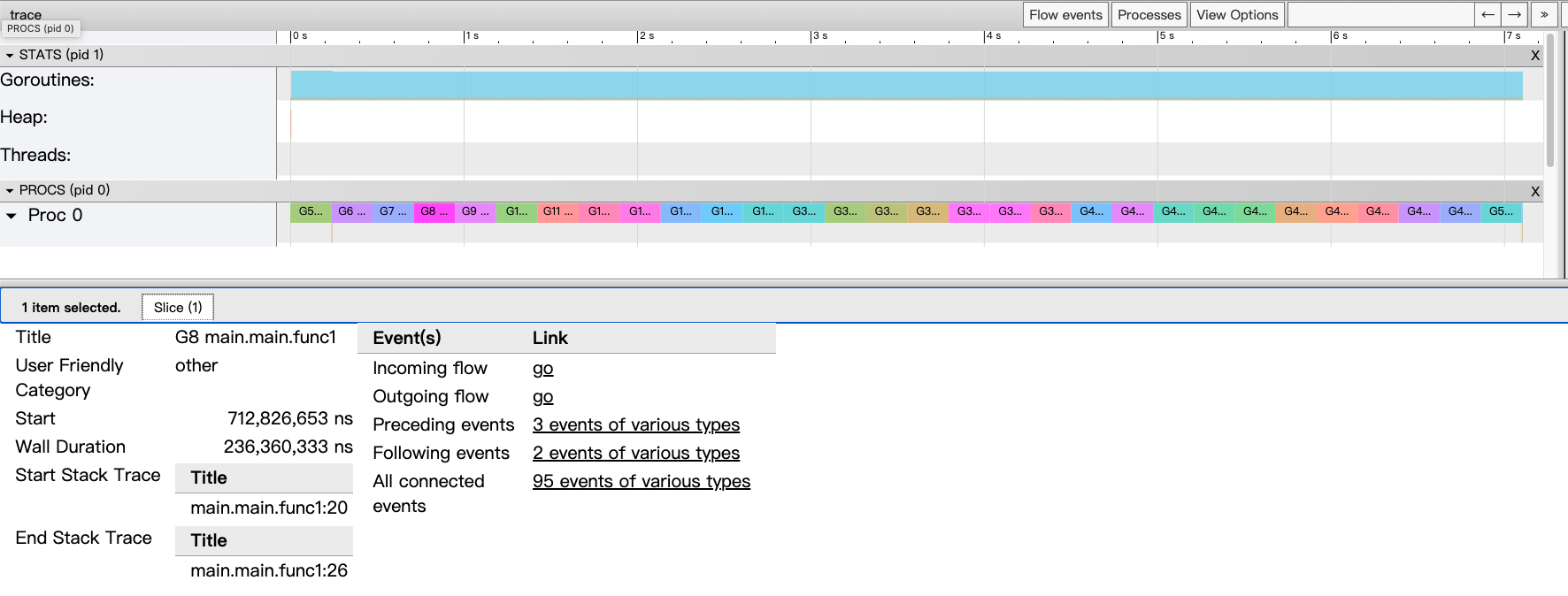
从上面的这个图可以看出:
- 因为我们限定了只有一个 P,所以在 PROCS 这一栏里面只有一个 Proc0;
- 我们在 for 循环里面启动了 30 个 goroutines ,所以我们可以数一下 Proc0 里面的颜色框框,刚好30 个;
- 30 个 goroutines 在 Proc0 里面是串行执行的,一个执行完再执行另一个,没有进行抢占;
- 随便点击一个 goroutines 的详情栏可以看到 Wall Duration 为 0.23s 左右,表示这个 goroutines 持续执行了 0.23s,总共 10 个 goroutines 执行时间是 7s 左右;
- 切入调用栈 Start Stack Trace 是 main.main.func1:20,在代码上面是 func 函数执行头:
go func(); - 切走调用栈 End Stack Trace 是 main.main.func1:26,在代码上是 func 函数最后执行打印:
fmt.Println("total:", t);
从上面的 trace 分析可以知道,Go 的协作式调度对 calcSum 函数是毫无作用的,一旦执行开始,只能等执行结束。每个 goroutine 耗费了 0.23s 这么长的时间,也无法抢占它的执行权。
Go 1.14 以上 trace 分析
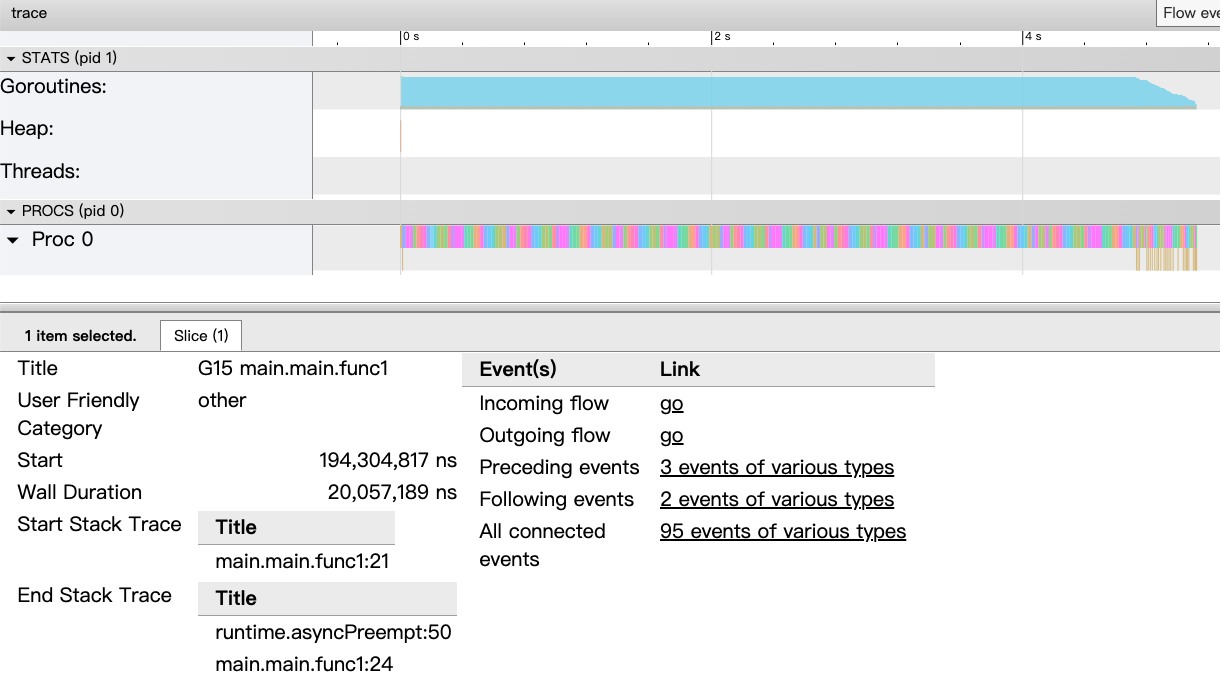
在 Go 1.14 之后引入了基于信号的抢占式调度,从上面的图可以看到 Proc0 这一栏中密密麻麻都是 goroutines 在切换时的调用情况,不会再出现 goroutines 一旦执行开始,只能等执行结束这种情况。
上面跑动的时间是 4s 左右这个情况可以忽略,因为我是在两台配置不同的机器上跑的(主要是我闲麻烦要找两台一样的机器)。
下面我们拉近了看一下明细情况:
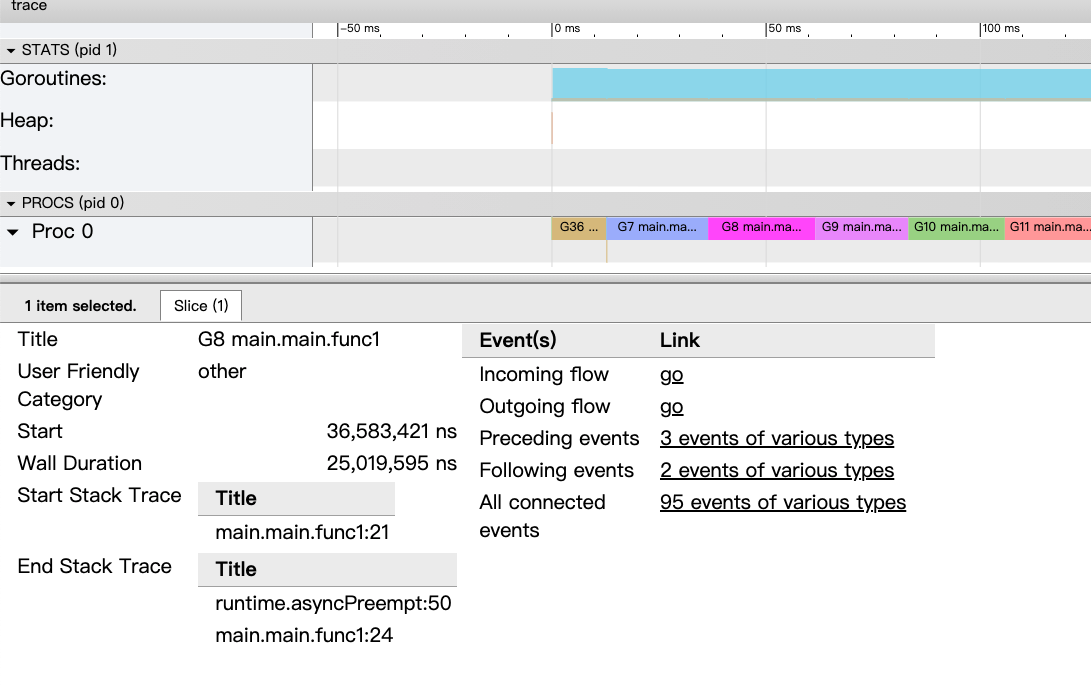
通过这个明细可以看出:
- 这个 goroutine 运行了 0.025s 就让出执行了;
- 切入调用栈 Start Stack Trace 是 main.main.func1:21,和上面一样;
- 切走调用栈 End Stack Trace 是 runtime.asyncPreempt:50 ,这个函数是收到抢占信号时执行的函数,从这个地方也能明确的知道,被异步抢占了;
分析
抢占信号的安装
runtime/signal_unix.go
程序启动时,在runtime.sighandler中注册 SIGURG 信号的处理函数runtime.doSigPreempt。
initsig
func initsig(preinit bool) {
// 预初始化
if !preinit {
signalsOK = true
}
//遍历信号数组
for i := uint32(0); i < _NSIG; i++ {
t := &sigtable[i]
//略过信号:SIGKILL、SIGSTOP、SIGTSTP、SIGCONT、SIGTTIN、SIGTTOU
if t.flags == 0 || t.flags&_SigDefault != 0 {
continue
}
...
setsig(i, funcPC(sighandler))
}
}
在 initsig 函数里面会遍历所有的信号量,然后调用 setsig 函数进行注册。我们可以查看 sigtable 这个全局变量看看有什么信息:
var sigtable = [...]sigTabT{
/* 0 */ {0, "SIGNONE: no trap"},
/* 1 */ {_SigNotify + _SigKill, "SIGHUP: terminal line hangup"},
/* 2 */ {_SigNotify + _SigKill, "SIGINT: interrupt"},
/* 3 */ {_SigNotify + _SigThrow, "SIGQUIT: quit"},
/* 4 */ {_SigThrow + _SigUnblock, "SIGILL: illegal instruction"},
/* 5 */ {_SigThrow + _SigUnblock, "SIGTRAP: trace trap"},
/* 6 */ {_SigNotify + _SigThrow, "SIGABRT: abort"},
/* 7 */ {_SigPanic + _SigUnblock, "SIGBUS: bus error"},
/* 8 */ {_SigPanic + _SigUnblock, "SIGFPE: floating-point exception"},
/* 9 */ {0, "SIGKILL: kill"},
/* 10 */ {_SigNotify, "SIGUSR1: user-defined signal 1"},
/* 11 */ {_SigPanic + _SigUnblock, "SIGSEGV: segmentation violation"},
/* 12 */ {_SigNotify, "SIGUSR2: user-defined signal 2"},
/* 13 */ {_SigNotify, "SIGPIPE: write to broken pipe"},
/* 14 */ {_SigNotify, "SIGALRM: alarm clock"},
/* 15 */ {_SigNotify + _SigKill, "SIGTERM: termination"},
/* 16 */ {_SigThrow + _SigUnblock, "SIGSTKFLT: stack fault"},
/* 17 */ {_SigNotify + _SigUnblock + _SigIgn, "SIGCHLD: child status has changed"},
/* 18 */ {_SigNotify + _SigDefault + _SigIgn, "SIGCONT: continue"},
/* 19 */ {0, "SIGSTOP: stop, unblockable"},
/* 20 */ {_SigNotify + _SigDefault + _SigIgn, "SIGTSTP: keyboard stop"},
/* 21 */ {_SigNotify + _SigDefault + _SigIgn, "SIGTTIN: background read from tty"},
/* 22 */ {_SigNotify + _SigDefault + _SigIgn, "SIGTTOU: background write to tty"},
/* 23 */ {_SigNotify + _SigIgn, "SIGURG: urgent condition on socket"},
/* 24 */ {_SigNotify, "SIGXCPU: cpu limit exceeded"},
/* 25 */ {_SigNotify, "SIGXFSZ: file size limit exceeded"},
/* 26 */ {_SigNotify, "SIGVTALRM: virtual alarm clock"},
/* 27 */ {_SigNotify + _SigUnblock, "SIGPROF: profiling alarm clock"},
/* 28 */ {_SigNotify + _SigIgn, "SIGWINCH: window size change"},
/* 29 */ {_SigNotify, "SIGIO: i/o now possible"},
/* 30 */ {_SigNotify, "SIGPWR: power failure restart"},
/* 31 */ {_SigThrow, "SIGSYS: bad system call"},
/* 32 */ {_SigSetStack + _SigUnblock, "signal 32"}, /* SIGCANCEL; see issue 6997 */
/* 33 */ {_SigSetStack + _SigUnblock, "signal 33"}, /* SIGSETXID; see issues 3871, 9400, 12498 */
...
}
具体的信号含义可以看这个介绍:Unix信号 https://zh.wikipedia.org/wiki/Unix信号。需要注意的是,抢占信号在这里是 _SigNotify + _SigIgn 如下:
{_SigNotify + _SigIgn, "SIGURG: urgent condition on socket"}
下面我们看一下 setsig 函数,这个函数是在 runtime/os_linux.go文件里面:
setsig
func setsig(i uint32, fn uintptr) {
var sa sigactiont
sa.sa_flags = _SA_SIGINFO | _SA_ONSTACK | _SA_RESTORER | _SA_RESTART
sigfillset(&sa.sa_mask)
...
if fn == funcPC(sighandler) {
// CGO 相关
if iscgo {
fn = funcPC(cgoSigtramp)
} else {
// 替换为调用 sigtramp
fn = funcPC(sigtramp)
}
}
sa.sa_handler = fn
sigaction(i, &sa, nil)
}
这里需要注意的是,当 fn 等于 sighandler 的时候,调用的函数会被替换成 sigtramp。sigaction 函数在 Linux 下会调用系统调用函数 sys_signal 以及 sys_rt_sigaction 实现安装信号。
执行抢占信号
到了这里是信号发生的时候进行信号的处理,原本应该是在发送抢占信号之后,但是这里我先顺着安装信号往下先讲了。大家可以跳到发送抢占信号后再回来。
上面分析可以看到当 fn 等于 sighandler 的时候,调用的函数会被替换成 sigtramp,sigtramp是汇编实现,下面我们看看。
src/runtime/sys_linux_amd64.s:
TEXT runtime·sigtramp<ABIInternal>(SB),NOSPLIT,$72
...
// We don't save mxcsr or the x87 control word because sigtrampgo doesn't
// modify them.
MOVQ DX, ctx-56(SP)
MOVQ SI, info-64(SP)
MOVQ DI, signum-72(SP)
MOVQ $runtime·sigtrampgo(SB), AX
CALL AX
...
RET
这里会被调用说明信号已经发送响应了,runtime·sigtramp会进行信号的处理。runtime·sigtramp会继续调用 runtime·sigtrampgo 。
这个函数在 runtime/signal_unix.go文件中:
sigtrampgo&sighandler
func sigtrampgo(sig uint32, info *siginfo, ctx unsafe.Pointer) {
if sigfwdgo(sig, info, ctx) {
return
}
c := &sigctxt{info, ctx}
g := sigFetchG(c)
...
sighandler(sig, info, ctx, g)
setg(g)
if setStack {
restoreGsignalStack(&gsignalStack)
}
}
func sighandler(sig uint32, info *siginfo, ctxt unsafe.Pointer, gp *g) {
_g_ := getg()
c := &sigctxt{info, ctxt}
...
// 如果是一个抢占信号
if sig == sigPreempt && debug.asyncpreemptoff == 0 {
// 处理抢占信号
doSigPreempt(gp, c)
}
...
}
sighandler 方法里面做了很多其他信号的处理工作,我们只关心抢占部分的代码,这里最终会通过 doSigPreempt 方法执行抢占。
这个函数在 runtime/signal_unix.go文件中:
doSigPreempt
func doSigPreempt(gp *g, ctxt *sigctxt) {
// 检查此 G 是否要被抢占并且可以安全地抢占
if wantAsyncPreempt(gp) {
// 检查是否能安全的进行抢占
if ok, newpc := isAsyncSafePoint(gp, ctxt.sigpc(), ctxt.sigsp(), ctxt.siglr()); ok {
// 修改寄存器,并执行抢占调用
ctxt.pushCall(funcPC(asyncPreempt), newpc)
}
}
// 更新一下抢占相关字段
atomic.Xadd(&gp.m.preemptGen, 1)
atomic.Store(&gp.m.signalPending, 0)
}
函数会处理抢占信号,获取当前的 SP 和 PC 寄存器并调用 ctxt.pushCall修改寄存器,并调用 runtime/preempt.go 的 asyncPreempt 函数。
// 保存用户态寄存器后调用asyncPreempt2
func asyncPreempt()
asyncPreempt 的汇编代码在 src/runtime/preempt_amd64.s中,该函数会保存用户态寄存器后调用 runtime/preempt.go 的 asyncPreempt2 函数中:
asyncPreempt2
func asyncPreempt2() {
gp := getg()
gp.asyncSafePoint = true
// 该 G 是否可以被抢占
if gp.preemptStop {
mcall(preemptPark)
} else {
// 让 G 放弃当前在 M 上的执行权利,将 G 放入全局队列等待后续调度
mcall(gopreempt_m)
}
gp.asyncSafePoint = false
}
该函数会获取当前 G ,然后判断 G 的 preemptStop 值,preemptStop 会在调用 runtime/preempt.go的 suspendG 函数的时候将 _Grunning 状态的 Goroutine 标记成可以被抢占 gp.preemptStop = true,表示该 G 可以被抢占。
下面我们看一下执行抢占任务会调用的 runtime/proc.go的 preemptPark函数:
preemptPark
func preemptPark(gp *g) {
status := readgstatus(gp)
if status&^_Gscan != _Grunning {
dumpgstatus(gp)
throw("bad g status")
}
gp.waitreason = waitReasonPreempted
casGToPreemptScan(gp, _Grunning, _Gscan|_Gpreempted)
// 使当前 m 放弃 g,让出线程
dropg()
// 修改当前 Goroutine 的状态到 _Gpreempted
casfrom_Gscanstatus(gp, _Gscan|_Gpreempted, _Gpreempted)
// 并继续执行调度
schedule()
}
preemptPark 会修改当前 Goroutine 的状态到 _Gpreempted ,调用 dropg 让出线程,最后调用 schedule 函数继续执行其他 Goroutine 的任务循环调度。
gopreempt_m
gopreempt_m 方法比起抢占更像是主动让权,然后重新加入到执行队列中等待调度。
func gopreempt_m(gp *g) {
goschedImpl(gp)
}
func goschedImpl(gp *g) {
status := readgstatus(gp)
...
// 更新状态为 _Grunnable
casgstatus(gp, _Grunning, _Grunnable)
// 使当前 m 放弃 g,让出线程
dropg()
lock(&sched.lock)
// 重新加入到全局执行队列中
globrunqput(gp)
unlock(&sched.lock)
// 并继续执行调度
schedule()
}
抢占信号发送
抢占信号的发送是由 preemptM 进行的。
这个函数在runtime/signal_unix.go文件中:
preemptM
const sigPreempt = _SIGURG
func preemptM(mp *m) {
...
if atomic.Cas(&mp.signalPending, 0, 1) {
// preemptM 向 M 发送抢占请求。
// 接收到该请求后,如果正在运行的 G 或 P 被标记为抢占,并且 Goroutine 处于异步安全点,
// 它将抢占 Goroutine。
signalM(mp, sigPreempt)
}
}
preemptM 这个函数会调用 signalM 将在初始化的安装的 _SIGURG 信号发送到指定的 M 上。
使用 preemptM 发送抢占信号的地方主要有下面几个:
- Go 后台监控 runtime.sysmon 检测超时发送抢占信号;
- Go GC 栈扫描发送抢占信号;
- Go GC STW 的时候调用 preemptall 抢占所有 P,让其暂停;
Go 后台监控执行抢占
系统监控 runtime.sysmon 会在循环中调用 runtime.retake抢占处于运行或者系统调用中的处理器,该函数会遍历运行时的全局处理器。
系统监控通过在循环中抢占主要是为了避免 G 占用 M 的时间过长造成饥饿。
runtime.retake主要分为两部分:
- 调用 preemptone 抢占当前处理器;
- 调用 handoffp 让出处理器的使用权;
抢占当前处理器
func retake(now int64) uint32 {
n := 0
lock(&allpLock)
// 遍历 allp 数组
for i := 0; i < len(allp); i++ {
_p_ := allp[i]
if _p_ == nil {
continue
}
pd := &_p_.sysmontick
s := _p_.status
sysretake := false
if s == _Prunning || s == _Psyscall {
// 调度次数
t := int64(_p_.schedtick)
if int64(pd.schedtick) != t {
pd.schedtick = uint32(t)
// 处理器上次调度时间
pd.schedwhen = now
// 抢占 G 的执行,如果上一次触发调度的时间已经过去了 10ms
} else if pd.schedwhen+forcePreemptNS <= now {
preemptone(_p_)
sysretake = true
}
}
...
}
unlock(&allpLock)
return uint32(n)
}
这一过程会获取当前 P 的状态,如果处于 _Prunning 或者 _Psyscall 状态时,并且上一次触发调度的时间已经过去了 10ms,那么会调用 preemptone 进行抢占信号的发送,preemptone 在上面我们已经讲过了,这里就不再复述。
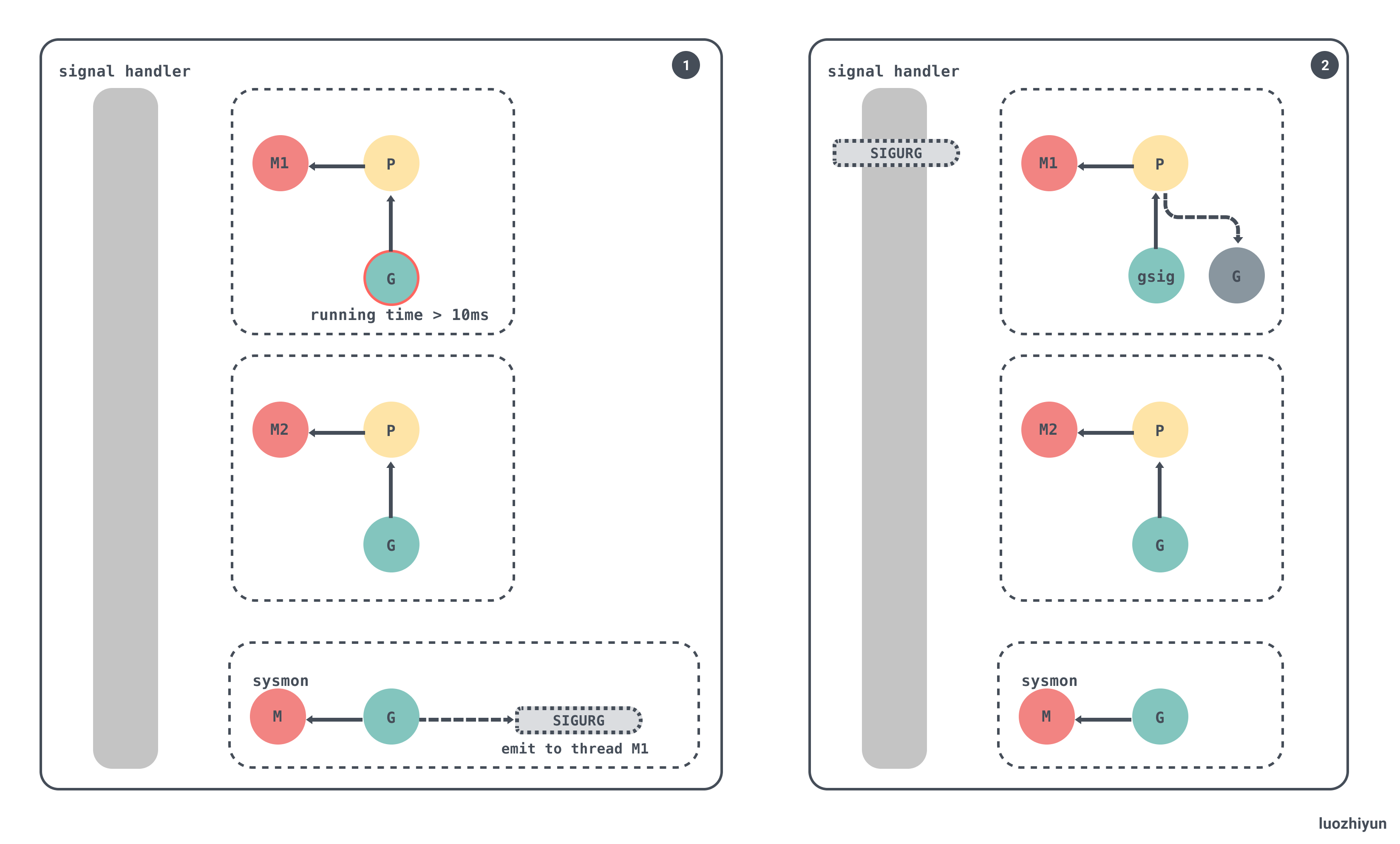
调用 handoffp 让出处理器的使用权
func retake(now int64) uint32 {
n := 0
lock(&allpLock)
// 遍历 allp 数组
for i := 0; i < len(allp); i++ {
_p_ := allp[i]
if _p_ == nil {
continue
}
pd := &_p_.sysmontick
s := _p_.status
sysretake := false
...
if s == _Psyscall {
// 系统调用的次数
t := int64(_p_.syscalltick)
if !sysretake && int64(pd.syscalltick) != t {
pd.syscalltick = uint32(t)
// 系统调用的时间
pd.syscallwhen = now
continue
}
if runqempty(_p_) && atomic.Load(&sched.nmspinning)+atomic.Load(&sched.npidle) > 0 && pd.syscallwhen+10*1000*1000 > now {
continue
}
unlock(&allpLock)
incidlelocked(-1)
if atomic.Cas(&_p_.status, s, _Pidle) {
n++
_p_.syscalltick++
// 让出处理器的使用权
handoffp(_p_)
}
incidlelocked(1)
lock(&allpLock)
}
}
unlock(&allpLock)
return uint32(n)
}
这一过程会判断 P 的状态如果处于 _Psyscall 状态时,会进行一个判断,有一个不满足则调用 handoffp 让出 P 的使用权:
runqempty(_p_):判断 P 的任务队列是否为空;atomic.Load(&sched.nmspinning)+atomic.Load(&sched.npidle):nmspinning 表示正在窃取 G 的数量,npidle 表示空闲 P 的数量,判断是否存在空闲 P 和正在进行调度窃取 G 的 P;pd.syscallwhen+10*1000*1000 > now:判断是否系统调用时间超过了 10ms ;
Go GC 栈扫描发送抢占信号
GC 相关的内容可以看这篇:《Go语言GC实现原理及源码分析 https://www.luozhiyun.com/archives/475》。Go 在 GC 时对 GC Root 进行标记的时候会扫描 G 的栈,扫描之前会调用 suspendG 挂起 G 的执行才进行扫描,扫描完毕之后再次调用 resumeG 恢复执行。
该函数在:runtime/mgcmark.go:
markroot
func markroot(gcw *gcWork, i uint32) {
...
switch {
...
// 扫描各个 G 的栈
default:
// 获取需要扫描的 G
var gp *g
if baseStacks <= i && i < end {
gp = allgs[i-baseStacks]
} else {
throw("markroot: bad index")
}
...
// 转交给g0进行扫描
systemstack(func() {
...
// 挂起 G,让对应的 G 停止运行
stopped := suspendG(gp)
if stopped.dead {
gp.gcscandone = true
return
}
if gp.gcscandone {
throw("g already scanned")
}
// 扫描g的栈
scanstack(gp, gcw)
gp.gcscandone = true
// 恢复该 G 的执行
resumeG(stopped)
})
}
}
markroot 在扫描栈之前会切换到 G0 转交给g0进行扫描,然后调用 suspendG 会判断 G 的运行状态,如果该 G 处于 运行状态 _Grunning,那么会设置 preemptStop 为 true 并发送抢占信号。
该函数在:runtime/preempt.go:
suspendG
func suspendG(gp *g) suspendGState {
...
const yieldDelay = 10 * 1000
var nextPreemptM int64
for i := 0; ; i++ {
switch s := readgstatus(gp); s {
...
case _Grunning:
if gp.preemptStop && gp.preempt && gp.stackguard0 == stackPreempt && asyncM == gp.m && atomic.Load(&asyncM.preemptGen) == asyncGen {
break
}
if !castogscanstatus(gp, _Grunning, _Gscanrunning) {
break
}
// 设置抢占字段
gp.preemptStop = true
gp.preempt = true
gp.stackguard0 = stackPreempt
asyncM2 := gp.m
asyncGen2 := atomic.Load(&asyncM2.preemptGen)
// asyncM 与 asyncGen 标记的是循环里 上次抢占的信息,用来校验不能重复抢占
needAsync := asyncM != asyncM2 || asyncGen != asyncGen2
asyncM = asyncM2
asyncGen = asyncGen2
casfrom_Gscanstatus(gp, _Gscanrunning, _Grunning)
if preemptMSupported && debug.asyncpreemptoff == 0 && needAsync {
now := nanotime()
// 限制抢占的频率
if now >= nextPreemptM {
nextPreemptM = now + yieldDelay/2
// 执行抢占信号发送
preemptM(asyncM)
}
}
}
...
}
}
对于 suspendG 函数我只截取出了 G 在 _Grunning 状态下的处理情况。该状态下会将 preemptStop 设置为 true,也是唯一一个地方设置为 true 的地方。preemptStop 和抢占信号的执行有关,忘记的同学可以翻到上面的 asyncPreempt2 函数中。
Go GC StopTheWorld 抢占所有 P
Go GC STW 是通过 stopTheWorldWithSema 函数来执行的,该函数在 runtime/proc.go:
stopTheWorldWithSema
func stopTheWorldWithSema() {
_g_ := getg()
lock(&sched.lock)
sched.stopwait = gomaxprocs
// 标记 gcwaiting,调度时看见此标记会进入等待
atomic.Store(&sched.gcwaiting, 1)
// 发送抢占信号
preemptall()
// 暂停当前 P
_g_.m.p.ptr().status = _Pgcstop // Pgcstop is only diagnostic.
...
wait := sched.stopwait > 0
unlock(&sched.lock)
if wait {
for {
// 等待 100 us
if notetsleep(&sched.stopnote, 100*1000) {
noteclear(&sched.stopnote)
break
}
// 再次进行发送抢占信号
preemptall()
}
}
...
}
stopTheWorldWithSema 函数会调用 preemptall 对所有的 P 发送抢占信号。
preemptall 函数的文件位置在 runtime/proc.go:
preemptall
func preemptall() bool {
res := false
// 遍历所有的 P
for _, _p_ := range allp {
if _p_.status != _Prunning {
continue
}
// 对正在运行的 P 发送抢占信号
if preemptone(_p_) {
res = true
}
}
return res
}
preemptall 调用的 preemptone 会将 P 对应的 M 中正在执行的 G 并标记为正在执行抢占;最后会调用 preemptM 向 M 发送抢占信号。
该函数的文件位置在 runtime/proc.go:
preemptone
func preemptone(_p_ *p) bool {
// 获取 P 对应的 M
mp := _p_.m.ptr()
if mp == nil || mp == getg().m {
return false
}
// 获取 M 正在执行的 G
gp := mp.curg
if gp == nil || gp == mp.g0 {
return false
}
// 将 G 标记为抢占
gp.preempt = true
// 在栈扩张的时候会检测是否被抢占
gp.stackguard0 = stackPreempt
// 请求该 P 的异步抢占
if preemptMSupported && debug.asyncpreemptoff == 0 {
_p_.preempt = true
preemptM(mp)
}
return true
}
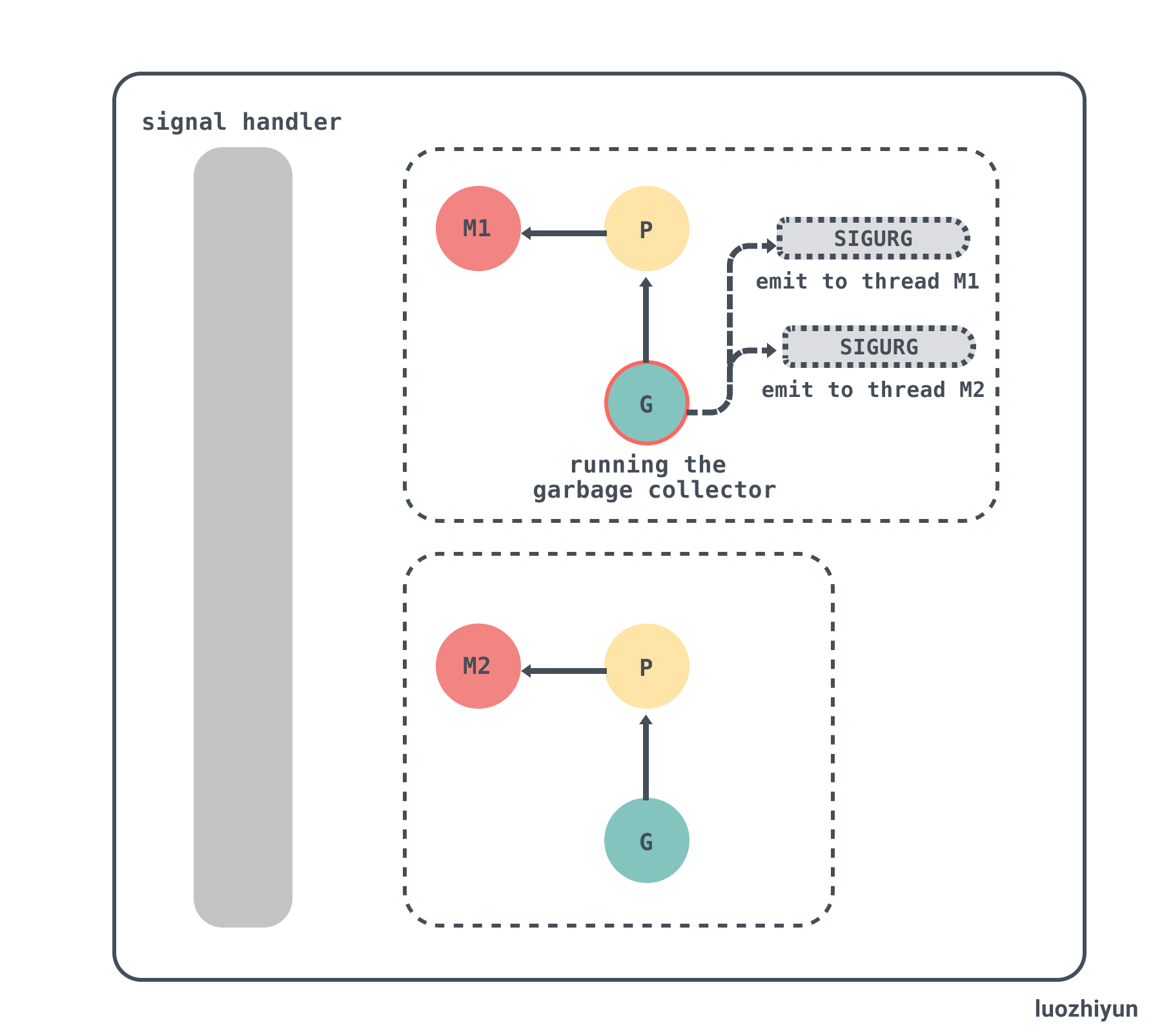
总结
到这里,我们完整的看了一下基于信号的抢占调度过程。总结一下具体的逻辑:
- 程序启动时,在注册
_SIGURG信号的处理函数runtime.doSigPreempt; - 此时有一个 M1 通过 signalM 函数向 M2 发送中断信号
_SIGURG; - M2 收到信号,操作系统中断其执行代码,并切换到信号处理函数
runtime.doSigPreempt; - M2 调用
runtime.asyncPreempt修改执行的上下文,重新进入调度循环进而调度其他 G;

Reference
Linux用户抢占和内核抢占详解 https://blog.csdn.net/gatieme/article/details/51872618
sysmon 后台监控线程做了什么 https://www.bookstack.cn/read/qcrao-Go-Questions/goroutine 调度器-sysmon 后台监控线程做了什么.md
Go: Asynchronous Preemption https://medium.com/a-journey-with-go/go-asynchronous-preemption-b5194227371c
Unix信号 https://zh.wikipedia.org/wiki/Unix信号
Linux信号(signal)机制 http://gityuan.com/2015/12/20/signal/
Golang 大杀器之跟踪剖析 trace https://juejin.cn/post/6844903887757901831
详解Go语言调度循环源码实现 https://www.luozhiyun.com/archives/448
信号处理机制 https://golang.design/under-the-hood/zh-cn/part2runtime/ch06sched/signal/#662-
